Tricontinental /Summary, April 16, 2024.
This dossier makes an X-ray of the Landless Rural Workers Movement (MST) and analyzes its forms of organization and struggle.
The works in this dossier are part of the 40-year MST
Art Convocation, organized by the Landless Movement, the Tricontinental
Institute for Social Research, ALBA Movements and the International
People's Assembly.
We want to thank the xs more than 150 artists
who presented themselves. Their contribution and solidarity with this
process further enriches and beautifies the struggle of the working
class, especially the peasant struggle, in addition to giving
reflections on the challenges ahead.
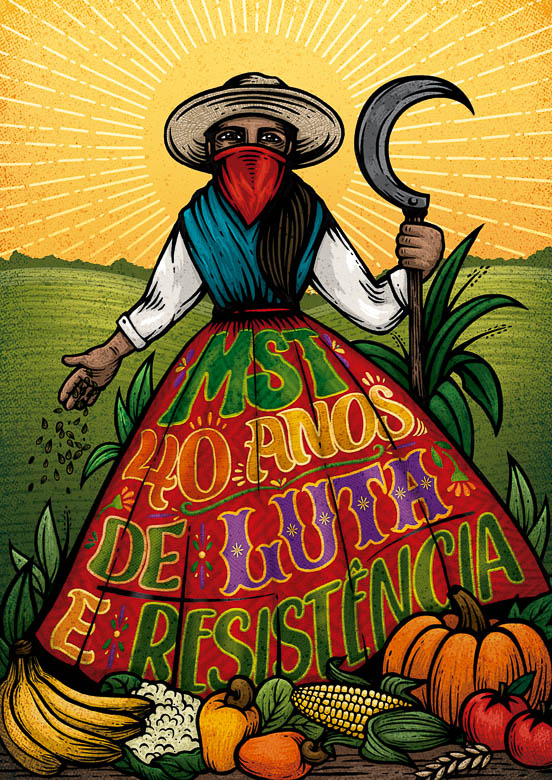
Artwork: Judy Duarte.Top
Introduction
In
September 1982, 30 rural workers and 22 pastoral agents met in Goiania,
the capital of the state of Goiás, in the central region of Brazil, at a
meeting organized by the Pastoral Commission of the Earth (CPT), an arm
of the Catholic Church inspired by Liberation Theology. These few
leaders represented the first peasant actions after 18 years of
repression of the peasant struggle by the business-military
dictatorship, which ruled the country for 21 years (1964-1985).
The
scenario was hopeful. The dictatorship languished in the face of the
economic failure and resurgence of mass struggles in the country,
especially a new trade union movement that would produce new leadership
and lead to the founding of the Workers' Party (PT) in 1980 and the One
Workers' Central (CUT), a vigorous unparalleled trade union center in
the history of Brazil, in 1983. Similar contexts were observed
throughout the Latin American and Caribbean continent: other military
dictatorships also aligned with the United States were dying, while the
struggle in Nicaragua and El Salvador inspired the Cuban Revolution in
previous years.
Peasants were still a dispersed force carrying out
local actions in a country of continental proportions, and faced, in
addition to political repression, the consequences of a forced
modernization of agriculture based on high mechanization, the intensive
use of agrotoxics and subsidies for large rural properties, which
stimulated the rural exodus. Even so, since 1979, there have been
occupations of large land properties in some states in isolation. Many
of them had the contribution and participation of the CPT. The meeting
in Goiaia discussed the future of these actions and, in the end,
indicated the need to build a movement of the peasantry, national and
autonomous, to fight for agrarian reform. It took another two years for
these joints to give rise to the foundation in 1984, in Cascavel, state
of Paraná, of the Movement of Landless Rural Workers of Brazil (MST).
This first meeting was attended by 92 leaders.
Twelve years later,
in 1996, the MST was already organized in all regions of the country,
had conquered land for thousands of families, its agrarian reform
settlements received the support and solidarity of other Brazilian and
international left-wing organizations, but it was still not considered a
relevant force in the political struggle, and was unknown to the
majority of the country's urban population. That year, however,
thousands of peasants marched in the direction of Belém, the capital of
the state of Pará, in the Amazon region, demanding an audience with the
then governor.
During the march, in Eldorado dos Carajás, in the
south of the state of Pará, they were surrounded by police forces and
gunmen hired by large companies in the region. At the head of the
protesters was Oziel Alves, a 19-year-old boy, with the responsibility
of keeping the spirit of his companions with slogans and motivation.
Oziel was one of the leaders identified by the police and separated from
the group. Before he was kneered, the police asked him to repeat, in
front of the weapons, which he said a few minutes earlier by the
microphone. Oziel did not hesitate, and his last words were: Long live
the MST.
Oziel was one of the 19 people killed in what is known as
the Eldorado Two Carajás Massacre. The days after the murders were
recorded by the internationally renowned Brazilian photographer,
Sebastian Salgado, gaining worldwide impact. The images, accompanied by
the music of the singer-songwriter Chico Buarque of Hollanda, and the
words of the writer José Saramago, crossed the planet in an exhibition
entitled Terra.
But it was
not the tragedy that made the MST recognised as a political force, but
its response to the crackdown. The following year, in February, in the
face of government impunity and the paralysis of agrarian reform, the
MST decided to start a march, with 1,300 people, starting from three
points from the country and arriving in Brasilia, the federal capital,
on April 17, 1997, exactly one year after the massacre of Eldorado dos
Carajás. At the time, the Agrarian Development Minister said that the
march, which traveled about 1,000 kilometers, would never reach
Brasilia. However, on the scheduled day, the and the Landless entered
the capital accompanied by 100,000 people, in what became the largest
political act against the neoliberal government of then President
Fernando Henrique Cardoso. This demonstration of strength and
organization has since made the MST one of the main protagonists of the
political struggle in Brazil (MST, "Sem Terras Marcham" country.
In
2005, the MST held a new national march. On that occasion, the
President of the Republic was Luiz Inácio Lula da Silva, an old ally and
supporter of the struggle for agrarian reform. The march aimed to raise
awareness among the government about the changes brought about by the
financing of agriculture and demanding a new National Agrarian Reform
Plan.1
The
First National Agrarian Reform Plan was announced by the first civil
government after the business-military dictatorship in 1985, but was
never executed.Note at the foot
of May 2 to 17 May of that year, 15,000 people marched, a small moving
city that raised its tents every day in a new place of the tour, with
kitchens to feed, bathrooms, infrastructure for the nannies that
accompanied their mothers and fathers, and studies after the days of
marching. To ensure the organization of the ranks, a mobile radio
transmitter accompanied the march, and was heard by the 15,000 radios
carried by the peasants. After this march, the Brazilian Army invited
the MST to give a lecture at the Higher War College to understand how a
popular movement had such an organizational degree (MST, 2006).
Throughout
its four decades of existence, completed in 2024, the MST has achieved
some significant victories: 450 thousand families conquered land,
transformed into settlements of agrarian reform. These settlements,
where work can be individual or cooperative, have led to the creation of
185 cooperatives from local agricultural production cooperatives to
marketing cooperatives and the provision of services with regional scope
and 1,900 peasant associations. Part of the settlement is processed in
120 own agro-industries. In the camps, there are still 65,000 organized
families fighting for the legalization of land (MST, "Nossa Produ"o).
The
longevity of the MST is full of meaning. In all Brazilian history, no
peasant social movement has managed to survive even a decade against the
political, economic and military power of the big landowners. The
resilience of the MST has many components, such as the solidarity it has
received at the national and international levels. There are also
dimensions produced in the struggle that deserve further study, such as
the pedagogical proposal for education in the movement, political
formation, the organization of women, agroecological production and the
organization of cooperatives.
Among so many dimensions, the
Tricontinental Institute of Social Research chose the forms of
organization and struggle of the MST as the subject of this dossier.
Indeed, the strength of a popular movement comes from the number of
people it organizes and its method of organization. This is one of the
main explanations for how the Earthless Movement resists and grows in
the face of such an unequal correlation of forces. And this experience,
without pretending to offer formulas, but understood in the context of
the Brazilian struggle, can contribute to the reflections and
organizations of other popular and peasant movements around the world.
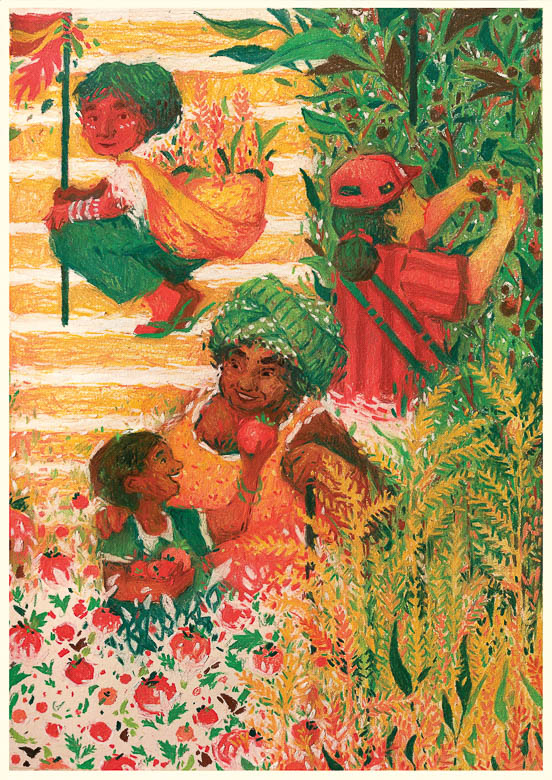
Artwork: Doubt Oliva.Top
The agrarian issue in Brazil
What
is now Brazil was founded and organized from the 16th century as a
capitalist company based on the great property of land, slave labor and
monoculture for export. The Portuguese colonial company caused a violent
rupture - by gunpowder and cross-size with the way of life of
indigenous societies, introducing a concept that did not make the
slightest sense for these communities: private property of nature's
common goods.2
Prior
to the arrival of the Portuguese, what is now Brazil was inhabited by
about 5 million people, divided into village communities, with community
dominance of the territory, dedicated to hunting, fishing, harvesting
and horticulture Maestri (2005).Nota al pie
In
1850, in the face of the eminent end of slavery due to abolitionist
movements and rebellions of the enslaved population, the then Brazilian
empire instituted the first Land Law to prevent the libertarians from
having access to the country's greatest source of wealth. By this law,
the land also became a commodity.
Moreover, this model called planting "monoculture slopes for export
based on the super-exploitation of the labor force" will be the only
constant in Brazilian history, regardless of sovereignty (Portuguese
colony or independent nation), the regime (monarchy or republic) and the
system of government (parliamentary or presidential).
Obviously,
in the face of this contradiction, the agrarian question has been at the
centre of rebellions, revolts and popular movements throughout the
country's history, from the indigenous resistance, the revolts against
slavery and the Quilombola communities 3
Of
the Quilombos, which are ancestral rural settlements with a majority
black population, initially created by escaped enslaved population. They
created their own form of organization and have rights similar to those
of indigenous territories.Nota al pie
The role of the State in defending the interests of landlords and
repression of the poor is also illustrative. While the indigenous and
enslaved populations were persecuted and fought by private militias, the
Brazilian Army itself tried to combat and eliminate the movements of
Canudos (1897), a self-managed community of 25,000 peasants, An armed
revolt of farmers to prevent an American railway company from taking
over its lands, and organizations fighting for agrarian reform before
the 1964 military-business coup, such as the Peasant Leagues.
As a
result, 21st-century Brazil continues to hold the second largest
concentration of land on the planet, a title it defended over the past
century, with 42.5% of properties under the control of less than 1% of
the owners (DIEESE, 2011). On the other side, 4.5 million peasants
considered landless.4
For a more detailed analysis of the agrarian issue in Brazil, see our dossier no. 27: https://thetricontinental.org/en/dossier-27-land/.Note to the foot
The class enemies of the landless are landowners, large landowners and transnational corporations that appropriate land for commodity
production. However, some of the pressure of the popular movement must
also be directed to the state. The current Brazilian Constitution was
approved in 1988, after the end of the business-military dictatorship,
and as it was built at a time of ascent of the mass struggles of people,
it incorporated many progressive aspects into its drafting, including
Agrarian Reform. Article 184 of the Federal Constitution provides that
agricultural property must fulfil a social function, must be productive
and respect labour and environmental rights. If they do not meet these
criteria, they can be expropriated for agrarian reform by the State,
responsible for compensating the owner or the owners and settling
landless families in these areas, which become public property.
The nature of the latifundio, however, has been transformed in recent decades according to the model of the so-called agribusiness.
The large unproductive and archaic property, used as a mechanism of
speculation, was incorporated by voluminous investments of international
financial capital, which controls sections of the rural production
chain, from seeds to the marketing of agro-industrial products. In 2016,
20 foreign groups controlled 2.7 million hectares in Brazil (Martins,
2020). This control accentuated monoculture for export, now converted
into commodities, large-scale
primary products marketed, with a unique global standard and used as
financial and speculative assets, negotiated on stock exchanges. In
Brazil in 2021, the obtaining of only five products, ear, corn, cotton,
sugar cane and livestock occupied 86% of any agricultural area and
represented 94% of all volume and 86% of the value of production (MST,
the Popular Agricultural Reform Programme). Agribusiness also depends on
the intensive use of agrotoxics, making the country the largest
consumer of agricultural poisons in the world, with a record consumption
of 130 thousand tons in 2023 (Spadotto and Gomes, 2021).
This
economic power is also expressed in political power. Agribusiness has
held ministerial positions in all Brazilian governments over the past
three decades. In the National Congress, Ruralist Banking, a supra-party
articulation of parliamentarians in defense of the interests of the
sector, brings together 324 federal deputies (61% of the House) and 50
senators (35% of the Senate) (FPA, 2023), sufficient power to impose
environmental and agrarian deregulation laws and to subject the MST to
inquiries in four Parliamentary Commissions of Inquiry (CPI) in two
decades. No other popular organization in Brazil's history has suffered
so many attempts at criminalization by Parliament. The first was created
during the first government of President Lula da Silva to force the
executive branch to reverse its relations with the Movement and prevent
public resources from being allocated to agrarian reform, in addition to
criminalizing the struggle for land. The last ICC, in 2023, had similar
objectives, again the new government of Lula da Silva was wanted, but
it had the opposite effect. The MPs who led the commission were part of
the most radical core of former President Jair Bolsonaro's government.
The MST, in turn, had expanded its public recognition from its
solidarity actions in the COVID-19 pandemic. As a result, the ICC did
not gain political or media support, strengthened solidarity with the
Movement and did not even succeed in passing a final report.
Finally,
the hegemony of agribusiness in Brazilian society also combines the
sophisticated methods of a powerful cultural industry, from television
to music, with archaic methods of violence and repression. According to
the CPT's annual investigation into violence in the field,
in 2022 there were 2,018 incidents of social conflict in the
countryside, an increase of 33.6% over 2016, and 47 murders linked to
land or environmental issues (CPT, 2023).
In 1995, at its Third National Congress, the MST presented and approved for the first time its Agrarian Reform Program,
in which it presented its reading of the class struggle in the
Brazilian countryside and a set of proposals to transform the Brazilian
agrarian structure and living conditions in the rural area. In 2015, the
program was updated with a major theoretical and structural change:
while parties and universities mistakenly understood nature, and even
hailed the role of agribusiness in Brazil, the MST militancy
collectively built an interpretation that defined it as the presence of
transnational financial capital in the field for commodity
production. More than that, the MST pointed out that the existence of
agribusiness - and its ties with the State - disqualify a classic
agrarian reform, within the capitalist framework, of mere distribution
or democratization of access to land.
In this context, the MST was
forced to redefine its strategic actions and its agricultural
programme, formulating a new concept: the People's Agrarian Reform. In
addition to the distribution of land to peasants, the Popular Agrarian
Reform incorporates the need to produce healthy food for every
population, with a change of technological matrix towards agroecology
and the preservation of nature's common goods. This change also implies a
greater alliance with urban workers, the largest beneficiaries of
access to healthy and cheap food, as the Popular Agrarian Reform goes
beyond the interests of the peasantry to present itself as a policy for
every society, both for food sovereignty, as an alternative to
employment and income generation, and to combat the environmental
catastrophe.
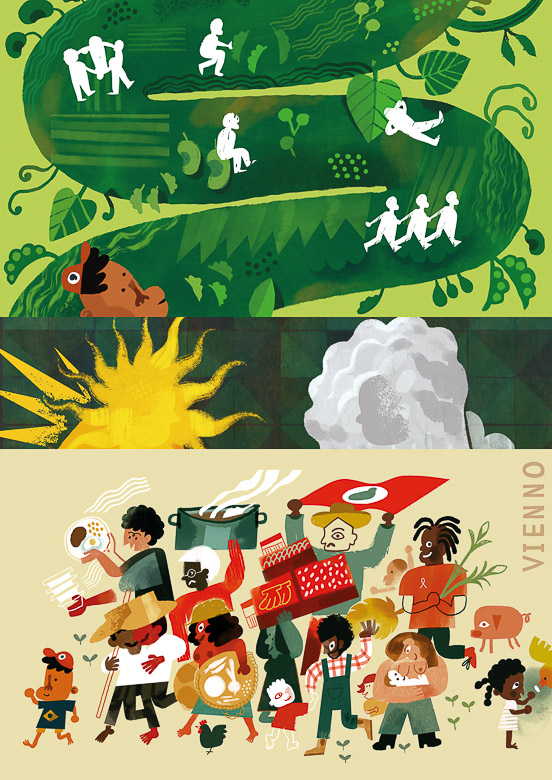
Artwork: Wine. Top
Forms of struggle and awareness-building
The
MST was born with three objectives: to fight for land, that is, that
families organized in the Movement will conquer enough land to survive
their own work with dignity; to fight for popular agrarian reform, which
means to restructure the property and use of land; and to fight for the
transformation of society.
To achieve these objectives, the MST
was organized and defined from the outset as a mass movement, of a trade
union, popular and political character. A demass movement because it understands that the correlation of forces can only change in its favor by the number of people organized and, therefore, popular, because it is an organization open to the participation of all people who want to fight to work the land. The MST also combines trade union character, because the struggle for agrarian reform has its economic dimension and its real and immediate, but also political, because it knows that agrarian reform can only be achieved with a structural transformation of society.
In
addition, the MST is a national movement with performance in 24 of
Brazil's 26 states, which differentiates it from the movements that
preceded it, which had local and regional action, which made it easier
for them to be isolated by repressive forces. Being present in most of
the country, the MST can support the most difficult states and
nationalize local struggles, amplifying its impact.
In this way,
the consolidation and strength of the MST is due to the number of people
it organizes. In fact, even if it has multiple forms of organization,
according to each reality and place, the fundamental thing in the method
of organization is to put people in motion, in struggle. And through the struggle, develop their political and social consciousness.
The
Movement's first form of struggle is land occupations. Before or during
the occupation of an area, the MST organizes landless family camps.
These families meet identifying areas where peasants are concentrated
and organizing meetings, based on grassroots work that includes visits
to these people. From this moment on, families participate in the
organization of the future camp, looking for ways to get tarpaulins,
transport for families to carry out occupations, etc. In other words,
create the conditions for the occupation to come.
The camps have
the same role as the factories fulfilled in the formation of workers'
struggles in the 19th and 20th centuries. Gather the peasants in a
specific place, overcoming geographical isolation and allowing the
building of a sociability that serves as a basis for cooperation and
solidarity.
When they enter a camp, families are organized in
grassroots centres, groups of between 10 and 20 people. This small
number is established so that members can be known and prevented from
infiltrating unknown persons. In addition, divided into small groups,
more people can debate and express their views on the political
organization of the camp. In the cores, everyone has the right to use
the word, including nannies. In the camp, tasks must be organized and
distributed collectively: to search for water and firewood, to organize
food donations, to set up tents, to take care of security, to educate
children, etc. These tasks are organized in teams called sectors, made
up of members of the cores. I mean, every core has a participant in the
work teams. In this way, everyone participates in political life,
through debates, and in organizational life, through tasks. Always
collectively.
Regardless of the number of people participating,
meetings of the nuclei and sectors are always organized in advance, on a
well-defined agenda and always coordinated by a man and a woman. A
person has the task of registering decisions so that they are verified
by the core itself.
When discussions are related to decisions
across the camp, the views of the cores are taken to a coordination
space for the whole camp. If there is no consensus at that level, the
discussions return to the cores, with new ideas and questions, always
seeking to build synthesis and collective decisions.
In these
camps and in the occupations of land, assemblies are common to make
collective decisions, such as whether or not to occupy a latifundio,
whether or not they are retreating into a struggle. But this method of
assembly is only effective when all participants understand all the
dimensions of what is under discussion and the discussions are limited
to a few options, such as whether or not to make an occupation, whether
or not to resist eviction. For this reason, they are neither the main
nor the most common form of participation in the Movement.
When
the land is conquered, the occupation becomes a settlement of agrarian
reform and families remain organized in the Movement. This was one of
the first challenges of the Movement: how to keep families who had
already achieved some of their goals organized with the conquest of the
land? Part of the sociability and cooperation in the camp is lost in
this transition. That is why the Movement developed some mechanisms to
keep the people and those based on the move.
First,
years of life and struggle in camps produce an identity. The workers
organized by the MST are identified as No Earth (with capital letters).
That identity remains even after you have conquered the land. This
identity means sharing stories of struggles, identification with
families who remain camped and with values such as internationalism and
solidarity that are cultivated in struggles.
The organization of
the conquered territory brings new demands and struggles for rural
credit, education, health, culture, communication, etc. To achieve these
new demands, the MST maintains its organizational form. In other words,
families in the settlements are also organized in grassroots,
neighbourhood-based centres of between 10 and 20 members, with the
participation of all families. These nuclei again have a man and a woman
in coordination, the preparation of meetings, the registration of
decisions and also a flow of discussions and debates that goes from the
nuclei to coordination and vice versa. At each organizational level -
camp, settlement, region, state and national - a collective leadership
body is created.
The MST has and has never had a president or a
similar position that concentrated political decisions or differentiates
itself from the other militants. All the bodies of the Movement, from
the grassroots to the National Directorate, are collective and with two
years renewable. In this way, centralism and personalism are combated.
Related to this principle, there is the division of tasks: all people
must have responsibilities within the organization, to a greater or
lesser extent, so that there is neither excessive centralization nor
overload of militants.
Thus, in a camp or settlement there are
teams for daily tasks. The new demands are distributed among the
education, health, economic organization teams, among others. The more
complex the reality and the more the organization, the more teams are
trained, organizing in sectors at the state and national levels to plan
and execute more specialized tasks, such as production, mass front,
education, training, etc. For example, all educators or persons involved
in the education of the same region of municipalities form the
education sector, which prepares pedagogical proposals and participates
in the school life of the territories. In production, militants organize
economic life, cooperatives, as well as agroecological technology for
cultivation. And so on.
In these groups, the protagonisms of
subjects Without Earth are also recognized and integrated as the
collective of sexual dissents - something very rare in other peasant
organizations - and youth. Another form of participation is the
activities and meetings with the "sem terrinhas," the nannies of the
agrarian reform areas. In July 2018, the first National Encontro two Sem Terrinhas brought together more than a thousand boys and girls at a study camp, games and struggles in the federal capital, Brasilia.
Again,
the essential thing is to bring people together, create spaces for
collective discussion and move them through struggle and cooperation.
This means that, although land occupations are the presentation rate of
the MST, the movement combines different forms of struggle according to
the needs and conditions of each case. Within the repertoire of
mobilizations we also find marches - such as the major national marches
of 1997 and 2005 - the occupations of public buildings, roadblocks,
hunger strikes, etc.
It is practical action, the struggle, that
allows political consciousness not to fall asleep in camps or
settlements. For example, the MST has solidarity as one of its main
human and socialist values. But this is not only expressed in rhetoric
or speech. During the COVID-19 pandemic, for example, the Movement
donated more than a thousand tons of food in every country through the
organization of canteens, gardens and solidarity communities. Between
October and December 2023 alone, the MST sent 13 tons of food for
victims of Israeli attacks in the Gaza Strip (MST, 2023). The
organization of these actions requires discussions with families,
production planning, logistics organization, etc. In this process,
families know other realities, especially in urban areas, cooperate to
achieve their goals and experience these values in practice.
Another
mechanism may be the organization of cooperatives, where cooperation
takes place at work and distribution of surpluses, but also in the
organization of agro-dealities, concentrating people in common housing
centres, rather than rural isolation, and socializing domestic work,
with kitchens, dining rooms and collective nurseries.
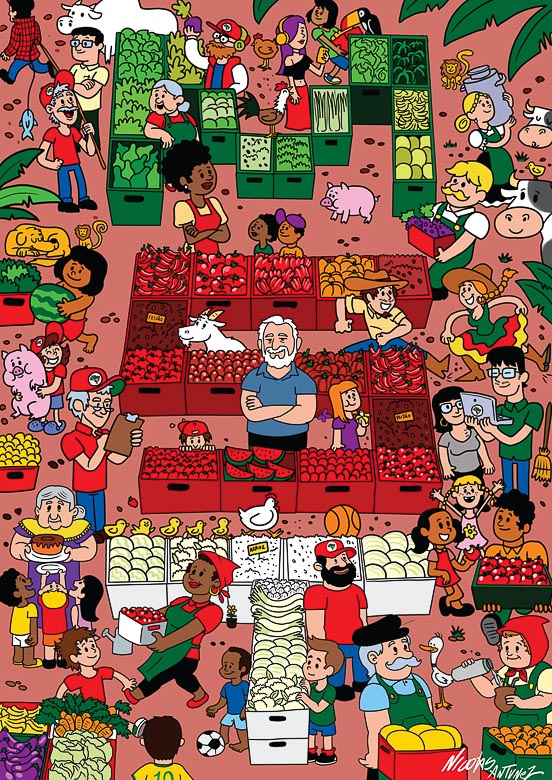
Artwork: Nicolas Antunez.Top
Organizational principles of the MST
As
a national and mass movement, the MST assumes the autonomy of its
states, regions and territories. In this way, each group of organized
families, in settlements or camps, has the authority to make decisions
about their reality. However, unity
is essential for this mechanism to function autonomously and uniformly
in its organizational forms. This is possible because, since its
foundation in 1984, the Landless Movement has established some
organizational characteristics that have determined the very identity of
the Movement.
Organizational principles are the values, the form
of organization and the objectives by which a popular movement is
preparing to fight. They define the identity and unity of an
organization, while the suppression of one of them would alter the
nature of the organization. During the four decades since its founding,
these characteristics have not changed in essence, but they have been
radicalized to increase participation and raise the level of
consciousness of the mass movement.
One of the principles is
autonomy from political parties, churches, governments and other
institutions. The MST is autonomous from other organizations to define
its own political agenda. That doesn't mean the MST doesn't work with
political parties or religious organizations, of course, but it's a
fraternal relationship and not subordinate to them. Thus, the MST can
build a reading of reality, of the struggle for land and establish
tactics based on its own perception and the demands of organized
families.
As has been seen before, for the Movement to be popular and mass, it must have participation
as an organizational principle. This is also an example of how the
principle can be broadened, radicalizing its nature, but preserving its
essence. Initially, men occupied most of the coordination bodies.
Present in the struggle of the MST from the beginning, the organization
of women grew in various ways, but mainly in the Women's Collective.
They organized political training camps, direct actions against
transnational corporations, study spaces on gender relations and
capitalism, etc. This role broadened the principle of participation when
at the end of the 1990s, the Movement established that all leadership
and representation positions should be compulsorily occupied by a man
and a woman. This literally doubled the number of participants and went
on to correspond to the real weight of women in the organization. This
mechanism reinforced another principle: collective leadership.
For
the principles of collective participation and leadership to work,
discipline is necessary. For the MST, discipline means respecting
collective decisions, political lines and complying with them. There are
rarely any votes in the MST, and the most common thing is to agree on
decisions. When there is some difficulty in reaching consensus on an
issue, the debate returns to the cores of the grassroots and
coordination until the decisions are ripe and, then, once the line of
action has been defined, all the members of the Movement follow and
carry it out. Discipline is this compliance with collective decisions.
A
common feature of social movements is that they build their strategies
and tactics on the basis of their own practice. Without action and
practice, there is no popular movement. However, in order to permanently
analyse reality, the practice alone is insufficient. Therefore, another
organizational principle valued by the MST is the study.
This ranges from schooling, organizing families to fight for schools in
the areas of settlements and camps, such as the more than 2,000 public
schools conquered in areas of agrarian reform thanks to pressure on
local authorities, to the literacy of young people and adults, with more
than 50,000 people who have learned to read and write on the initiative
of the Movement or in collaboration with local governments (MST,
Education. Another dimension of the study is political training through
different processes - publication of books and booklets, study in the
cores of the basics, courses, etc. and which are in a way synthesized in
the experience of the Florestan Fernandes National School (ENFF), the
national political formation school of the Movement, which is part of
the set of the training schools of the International Assembly of
Peoples, a global articulation of popular organizations, social
movements, political parties and trade unions.
ENFF opened on January 23, 2005, and its name pays tribute to Brazilian sociologist and Marxist militant Florestan Fernandes.5
Committed
to the class struggle, he was one of the founders of the Workers' Party
and federal deputy in the elaboration of the Brazilian Constitution
after the business-military dictatorship.Note to the foot
The school has become an international reference for linking practice
with political theory. Throughout the year, militants, leaders and
cadres of popular organizations fighting for the construction of social
change in various countries study in classic in-depth national and
international political theory. Courses can last from one week to three
months, and are taught by volunteer teachers and intellectuals. ENFF
also offers training courses focused on various topics, such as
agrarian, Marxism, feminism and diversity. With teachers and students
from several countries, especially from Latin America, Florestan
Fernandes allows a cultural and political exchange between popular
movements, as well as a training on the global economic and social
landscape, always from the perspective of the working class (MST, 2020).
The
school was built literally by the hands of Landless workers across the
country, who organized into volunteer work brigades. The resources for
the construction were raised thanks to the solidarity work of
international support committees and the donation of the copyright of
Sebastian Salgado, Chico Buarque and José Saramago with the exhibition Terra.
In
addition to ENFF, the Movement has created other schools such as the
Joshua de Castro Institute of Education, which specializes in training
young managers for cooperatives, and agroecology schools, such as the
Latin American School of Agroecology (ELAA) and the Instituto Educar, in
the southern region of the country; the Popular School of Agroecology
and Agrofloresta Egídio Brunetto (EPAAEB), located in the northeast; and
the Institute of Latin American Agroecology (IALA), in the Amazon
region.
Part of the efforts to democratize access to knowledge
also materialized in the National Education for Agrarian Reform
Programme (PRONERA), a public policy conquered after the 1997 National
March. Through this program, the Brazilian government encourages the
creation of specific education courses, including bachelor's and
postgraduate courses, for landless workers. More than 100 agreements
have been signed with public universities that allow access to courses
in Agronomy, Veterinary, Nursing, teacher training, among many others.
In this way, the Movement occupies a traditionally elitist and
difficult-to-reach space, while forcing the academy to open its doors to
experience and knowledge produced in the heat of the struggle.
Another of the main values fed by the MST is internationalism,
understood as value and as a political strategy. Capitalism, as a world
system, establishes the entire planet as a battlefield and therefore
resistance must also be global. In addition to the articulations between
peasant movements, such as La Via Campesina and the Latin American
Coordination of Rural Organizations (CLOC) in Latin America, the MST
participates in other broader coordination spaces, such as ALBA
Movimientos and the International Assembly of Peoples.
However,
internationalism is not limited to spaces for international meetings and
meetings. As the principle and value of the organization, it has to
materialize in actions. From the simplest expressions of solidarity with
the peoples in struggle on the part of the families camped and settled,
to the construction of internationalist brigades, formed by militants
of the Movement to participate in exchange missions in the areas of
agroecology, production, education and training. Organized since 2006,
the Internationalist MST Brigades have been in Venezuela, Haiti, Cuba,
Honduras, El Salvador, Bolivia, Paraguay, Guatemala, East Timor, China,
Mozambique, South Africa and Zambia.
The oldest of them, the
Apollonian Brigade of Carvalho, whose name honors a Brazilian communist
militant who fought in the Spanish Civil War and the French Resistance,
acts in Venezuela supporting the political formation and dissemination
of agroecological techniques. The Jean-Jacques Dessalines Brigade in
Haiti has been acting in the same way since before the earthquake that
destroyed the country in 2010. In Zambia, in addition to agroecology,
the Samora Machel Brigade works on peasant literacy and, in Palestine,
every two years, the Ghassan Kanafani Brigade collaborates in the
harvest of olives in territories threatened by Israeli settlers.
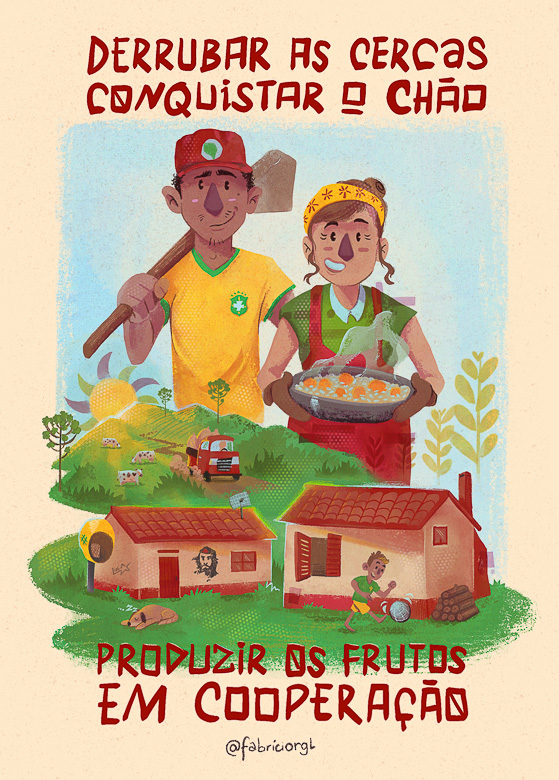
Artwork: Fabrício Rangel.Top
The future of the struggle for land in Brazil
The
characteristics of the new MST Agrarian Program are given by the
contradictions and demands proper to the struggle in the countryside.
They give us guidance from what direction the struggle for land should
take, not only in Brazil, but throughout the Global South. Here we
highlight some of these dimensions and challenges.
The struggle for land is increasingly international.
The high concentration of income and land caused by financial capital
reduced control of the entire agricultural production chain to only 87
corporations based in 30 countries (Pina, 2018). These transnational
corporations threaten biodiversity and local cultures with their demands
for food standardization, set prices globally and interfere with
national legislation and rights. This means that peasant resistance will
also have to be increasingly international, with platforms and joint
actions, with pressure on multilateral organizations, but mainly by
fighting these transnationals in all territories.
The fight for land is a technological struggle.
Agribusiness is also defined by the massive diffusion of GMOs and the
intensive use of agrotoxics (pesticides and fertilizers). These
characteristics are inherent in the agribusiness itself. Without this
technological package, it is not possible to produce monocultures on a
global scale. That's why agribusiness, green or sustainable, is just
advertising. The overcoming of this model requires the strengthening and
massification of experiments in agroecology, the recovery of soils and
biodiversity, the appropriation and dissemination of new techniques and
technologies of production and environmental preservation, and the
national production of machinery, equipment and agricultural tools
suitable for the needs of the peasantry.
But it's not just about technology in agricultural production. As we describe in our dossier no 46, the technological giants and current challenges for the class struggle
(Tricontinental, 2021), mergers and concentration characteristic of the
movements of financial capital have brought together technology
companies, technology financiers and agribusiness companies to determine
the technological standard of the machinery and appropriate thousands
of data of nature, - imprisoned - in the cloud infrastructure controlled
by the Global North.
The struggle for land is a struggle for food.
The COVID-19 pandemic showed how transnational corporations took
advantage of the global crisis to inflate food prices and benefit from
speculation. But subjecting food to the logic of the financial market
also has other consequences, such as reducing the production of
traditional or local crops in favour of commodities commodities
with greater market acceptance. Growings such as soy, whose destination
is the production of fuel or animal feed (Tricontinental, 2019),
convert old food plantations into monoculture deserts. Added to this is
the risk of generating food crises by committing future crops on stock
exchanges. Even so, when agribusiness does not reduce production or
hinder access to food, it is producing poor quality food, rich in
agrotoxic waste.
The fight for land is an environmental struggle.
Agribusiness is one of those responsible for the climate and
environmental catastrophe, mainly due to large-scale deforestation to
replace forests with commodity
plantations or extensive livestock, which also emits large amounts of
carbon. In addition, the model of agribusiness expansion implies
excessive and deregulated consumption of water resources, the
disappearance of traditional plant and seed varieties, immediate
environmental impacts, such as the reduction of soil biodiversity, among
others.
The combination of the struggle for land and
environmental struggle also requires denouncing the false solutions of
green capitalism such as the carbon credit market. In this context, one
of the initiatives with practical and immediate effect at the national
level is the goal of planting 100 million trees in the coming years. In
its first four years, the Movement has already planted 25 million trees.
A
good example of how the MST combines environmental, technological and
food struggles is in the organization of the families based in the
metropolitan region of Porto Alegre, in the south of the country. This
is the largest production of agroecological rice in Latin America. There
are more than a thousand families that produce individually or in local
cooperatives, but all organized in a central cooperative, which
provides technical assistance and assumes the industrialization and
marketing of the product. Families are involved in both technical
management, responsible for agroecological supervision and
certification, and in economic and political management. The production
of agroecological rice has become a symbol of the large-scale productive
capacity of agroecology, the commitment of the MST to healthy food and
also solidarity, since large quantities of grains are often donated to
both urban community canteens in the region and to other countries.
The struggle for land is a cultural battle. The
consolidation of the hegemony of agribusiness is not only due to
economic and technological control, but also through the dissemination
of neoliberal values and the defense of the "modo de vida," of
agribusiness through countless mechanisms of the cultural industry, with
constant advertising on television, sponsorship and financing of the
media, organization of shows and financing of artists who literally sing
odas to the fund of monoculture. The construction of a
counter-hegemonic model of agriculture implies transformations in the
mode of agricultural production and in the social relations themselves
in the countryside, with agroecology, cooperation and study in
opposition to monoculture, individualism and ignorance.
On the
other hand, agroecology has also become an ally to convey the message of
a different agricultural model, by bringing together the environmental,
health, popular and scientific knowledge and diversity of popular
culture. The MST Culture Collective is an example of how this can
develop. This Collective works to produce and strengthen a culture of
its own, based on work fronts in literature, theatre and plastic arts,
and has played an important role in the relationship with society,
organizing the Festivals of Agrarian Reform in the states, a mixture of
food fair with cultural activities with MST musicians and supporters of
the struggle. These festivals reproduce locally the successful
experience of the National Agrarian Reform Fairs, held in Sao Paulo,
whose fourth and most recent edition in 2023, brought together more than
320 thousand people over four days.
Finally, the struggle for the land is part and depends on the struggle of the workers as a whole. The
peasantry alone does not have enough strength to face the large
transnational corporations that control agriculture. To defeat them, it
takes a powerful mass movement. In addition, the defeats of these
corporations and financial capital would open windows of opportunity for
a socialist project. In other words, since the present stage of
capitalism has elevated its characteristics to its maximum power, every
defeat inflicted on this model must and can necessarily be
anti-capitalist and therefore contribute, from the countryside or in
alliance with urban workers, to the construction of a project of human
emancipation.
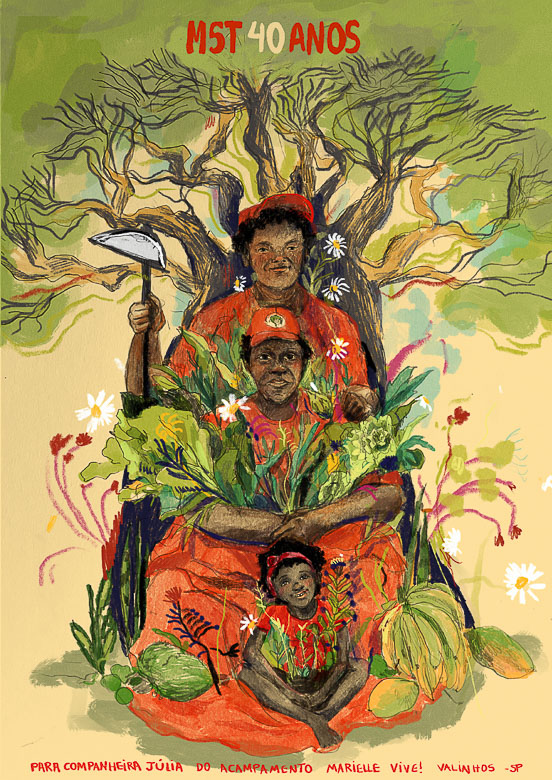
Artwork: Natália Gregorini.Top
Notes
1
The First National Agrarian Reform Plan was announced by the first
civilian government after the business-military dictatorship in 1985,
but was never executed.
2
Before the arrival of the Portuguese, what is now Brazil was inhabited
by about 5 million people, divided into village communities, with
community dominance of the territory, dedicated to hunting, fishing,
harvesting and horticulture Maestri (2005).
3
of the Quilombos, which are ancestral rural settlements with a mostly
black population, initially created by escaped enslaved population. They
created their own form of organization and have rights similar to those
of indigenous territories.
4 For a more detailed analysis of the agrarian issue in Brazil, see our dossier no. 27: https://thetricontinental.org/en/en/dossier-27-land/.
5
Committed to the class struggle, he was one of the founders of the
Workers' Party and federal deputy in the elaboration of the Brazilian
Constitution after the business-military dictatorship.Arriba
Bibliographical references
Castro,
Mariana. MST completes 37 years and show a fora gives family farming
during pandemic. MST, January 22, 2021. Available at: https://mst.org.br/2021/01/22/mst-completa-37-anos-e-mostra-a-forca-da-agriculture-familiar-during-a-pandemia/.
Comisso Pastoral da Terra. Conflitos no country Brazil 2022. Goi?nia: CPT Nacional, 2023. Available at: https://www.cptnacional.org.br/downlods/download/41-conflitos-no-campo-brasil-publicacao/14302-livro-2022-v21-web.
DIEESE. Statistics do rural 2010-2011.
4.ed. Sao Paulo: Intersindical Department of Statistics and
Socioeconomic Studies, Nucleus de Estudos Agrários y Desenvolvimento
Rural y Ministério do Desenvolvimento Agrário, 2011.
Agropecuario Parliamentary Front. All you're sore, July 25, 2023. Available at: https://fpagropecuaria.org.br/alldos-os-membros/.
Instituto
Brasileiro de Geografia e Estatística (IBGE) Censo Agropecuário,
Florestal e Aquícola 2017. Retrieved on March 29, 2024. https://censoagro2017.ibge.gov.br.
Tricontinental Institute for Social Research. Complexo da Soja: Análise dos dice nacionais e internacionai s, 13 November 2019. Available at: https://thetricontinental.org/pt-pt/brasil/complexo-da-soja-analise-dos-dados-nacionais-e-internacionais/.
Not Dossier. 46. The tech giants and the current challenges to the class struggle. November 1, 2021. Available at: https://thetricontinental.org/en/dossier-46-gigantes-tech/.
Gramsci em del Movimiento de Rural Landless Workers (MST): an interview with Neuri Rossetto, Dossier does not. 54, 19 July 2022. Available at: https://thetricontinental.org/en/dossier-54-gramsci-mst-rossetto/.
Jakobskind, Mario Augusto. Stedile facestra palestra na Escola Superior de Guerra, July 19, 2006. Available at: https://mst.org.br/2006/07/19/stedile-faz-palestra-na-escola-superior-de-war/.
Maestri,
Mario. Absent Aldeia: indiums, caboclos, cativos, inhabitants and
imigrants na forma.o da classe Camponesa brasileira. In: Stedile, Joao
Pedro (ed.). A questo agrária no Brasil, volume 2 . O debate na esquerda 1960-1980. Sao Paulo: Expressáo Popular, 2005, pp. 217-276.
Martins, Adalberto. A Quest.o Agrária no Brasil, volume 10 . Da colánia ao governo Bolsonaro. Sao Paulo: Expressáo Popular, 2022.
- Organic rice and popular agria reform. Sao Paulo: Popular Express, 2019.
Movimento dos Trabalhadores Rurais Sem Terra (MST). Sem Terras Marcham's hair Country. Available at: https://mst.org.br/nossa-history/97-99/.
Normas geris e Princípios Organizing. 2016.
It has been to Escola Nacional Florestan Fernandes, 15 years of training militants, January 24, 2020. Available at: https://mst.org.br/2020/01/24/conheca-a-escola-national-florestan-fernandes-ha-15-anos-formando-militants/.
In another donation, the MST sent 11 tons of food to families in Gaza, December 8, 2023. Available at: https://mst.org.br/2023/12/08/en-other-donacion-el-mst-envio-11-tons-from-food-a-las-familias-en-gaza/.
Educao. Retrieved 23 February 2024. https://mst.org.br/educacao/.
Nose Produ. Retrieved 23 February 2024: https://mst.org.br/nossa-producao/.
Program of Reform Popular Agriculture. 2024. Not published.
Pina, Rute. Only 87 companies control cadeia produtiva do agronegócio. Brazil of Fato, September 4, 2018. Available at: https://www.brasildefato.com.br/2018/09/04/so-87-enterprises-controlam-a-cadeia-produtiva-do-agronegoti.
Spadotto, Cláudio and Marco Antonio Ferreira Gomes. Agrotoxics not Brazil. Embrapa, December 22, 2021. Available at: https://www.embrapa.br/agencia-de-informacao-tecnologica/tematicas/agricultura-e-meio-environment/qualidade/ynamica/agrotoxicos-no-brasil:-text=Expresso%20quantidade%20de%20deredrediente,agr%C3%ADcola%20aumento%2078%25%20nesse%20per%C3%ADodo.
I'll
go, Lu. He has been to Escola Nacional Florestan Fernandes, 15 years of
age forming militants. MST, January 24, 2020. Available at: https://mst.org.br/2020/01/24/conheca-a-escola-national-florestan-fernandes-ha-15-anos-formando-militants/.
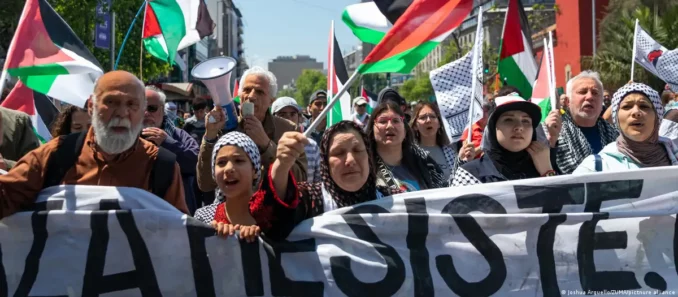


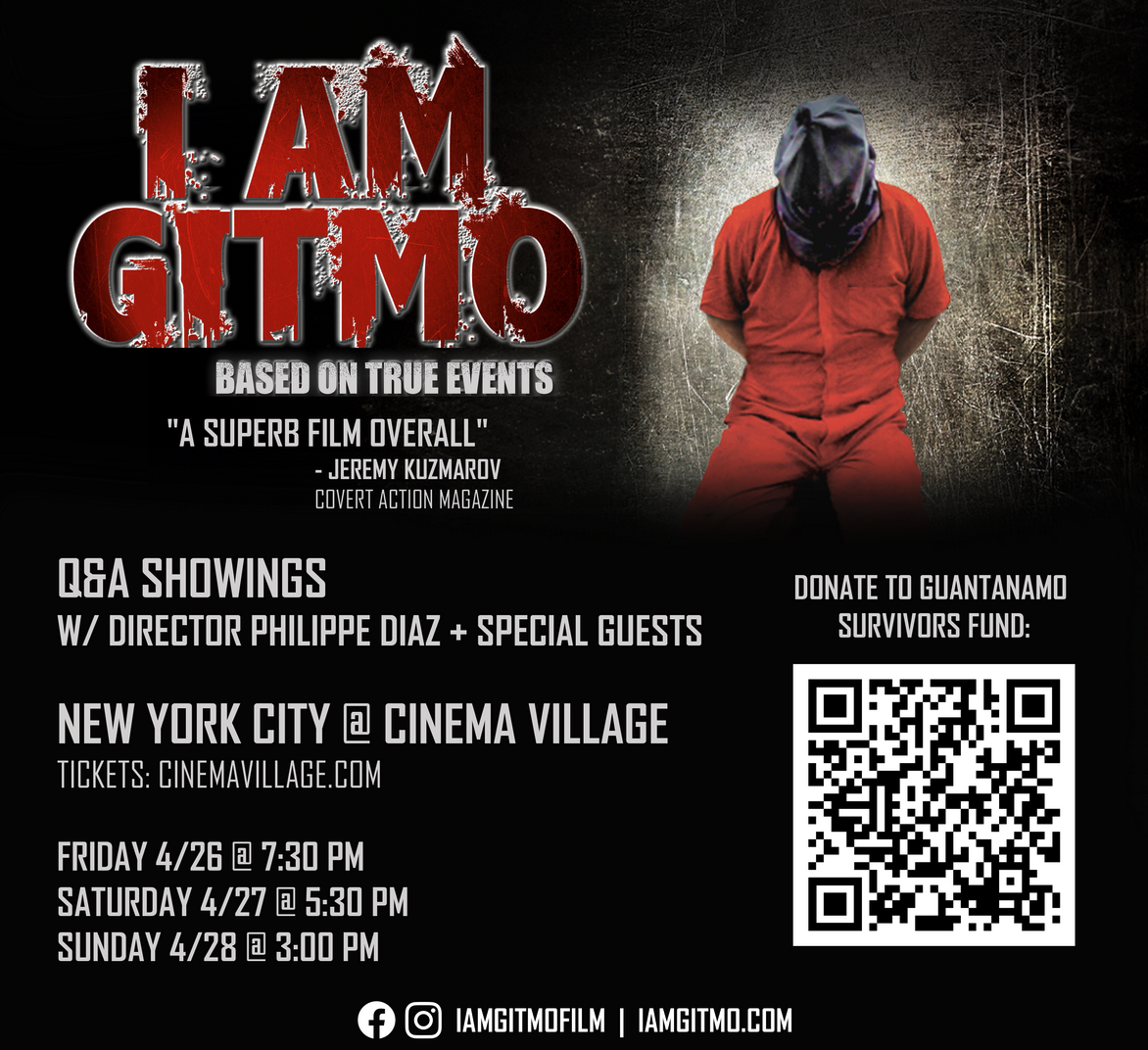
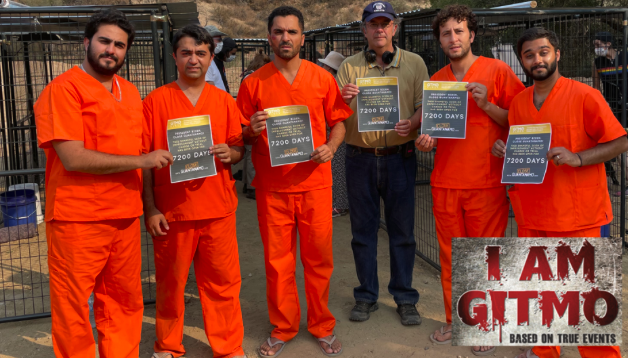
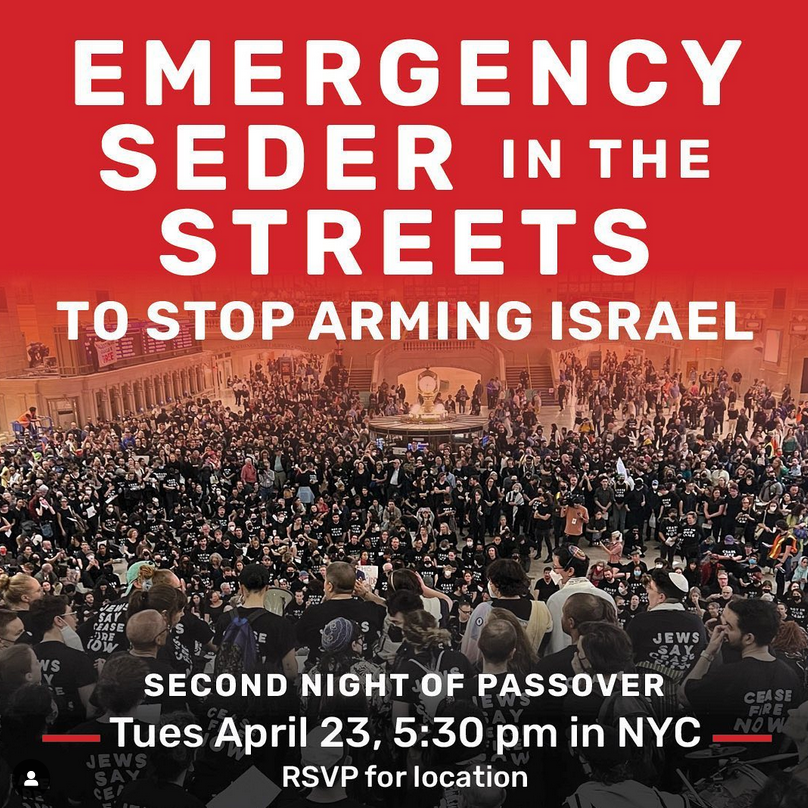
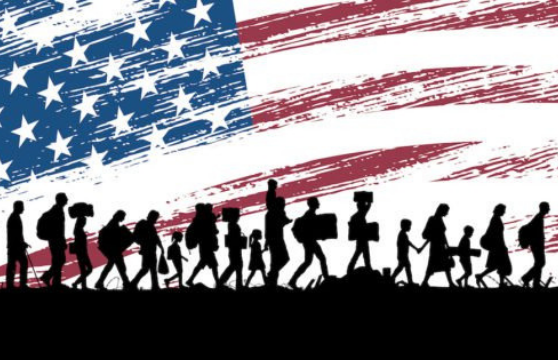






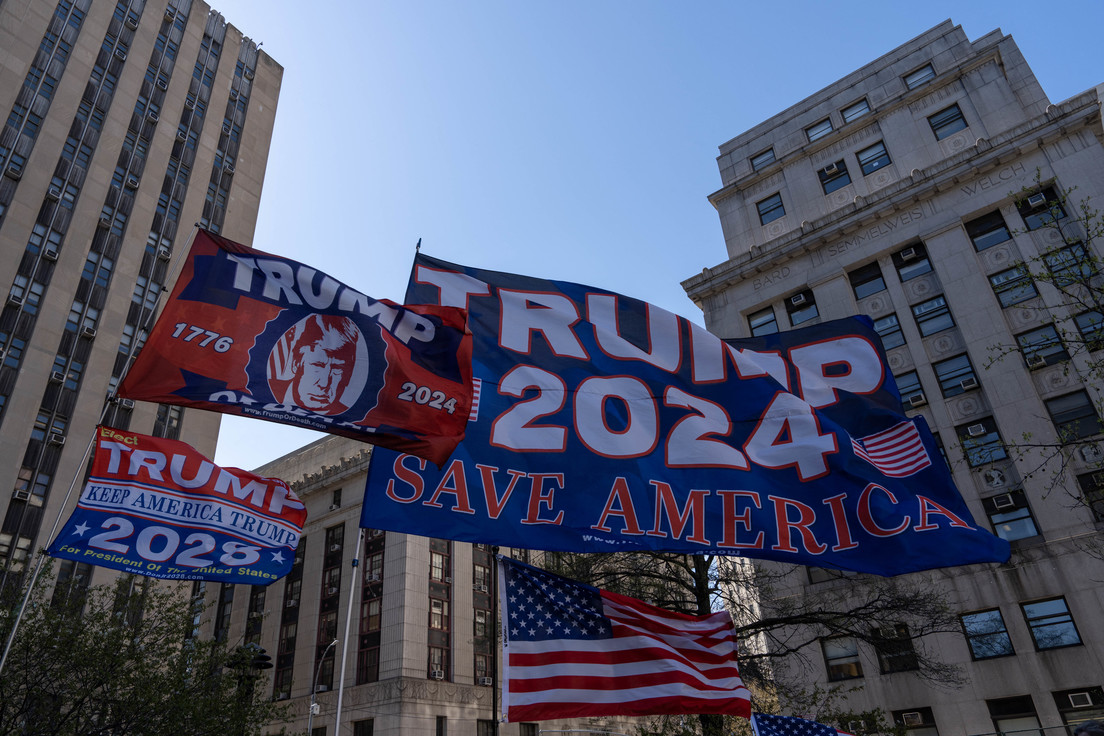
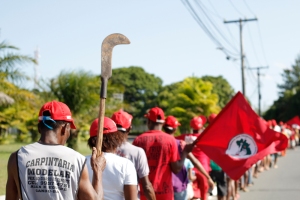
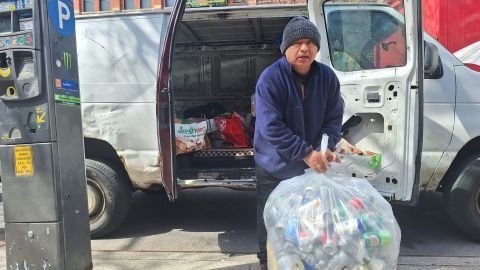






































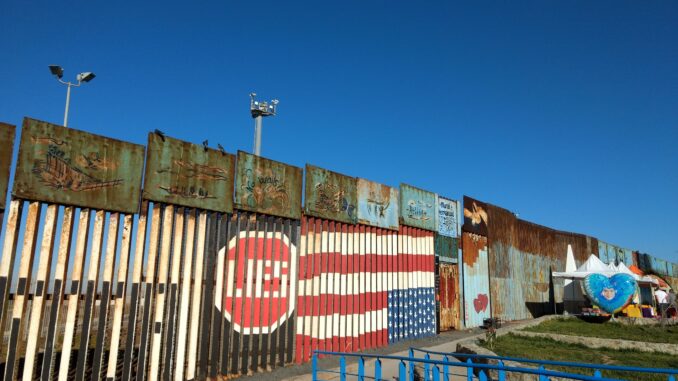








 [La pedagogía crítica y la lucha anti-fascista]....,
[La pedagogía crítica y la lucha anti-fascista]....,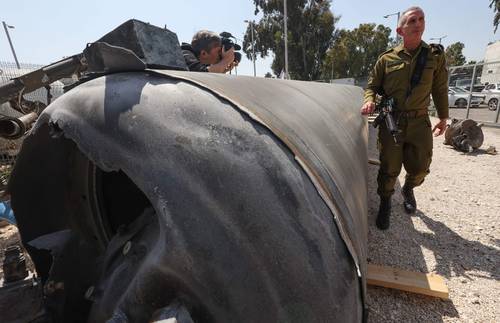 Israel
creyó que podría lanzar un golpe contra Irán sin sufrir consecuencias.
Esto ya se acabó, pese a que Irán en forma deliberada no infligió una
acción extremadamente letal
Israel
creyó que podría lanzar un golpe contra Irán sin sufrir consecuencias.
Esto ya se acabó, pese a que Irán en forma deliberada no infligió una
acción extremadamente letal
 En
regiones diferentes del mundo, esos altísimos gastos están al servicio
de una misma estrategia, la estrategia de dominación global de los
anglosajones.....,
En
regiones diferentes del mundo, esos altísimos gastos están al servicio
de una misma estrategia, la estrategia de dominación global de los
anglosajones.....,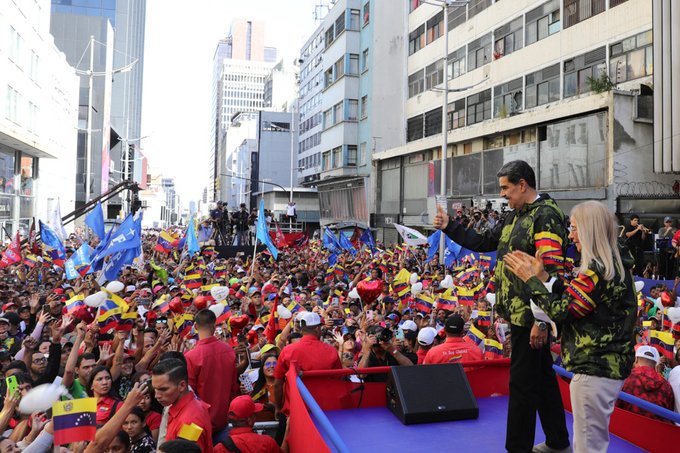 El
economista marxista argentino va a fondo en el análisis geopolítico, la
crítica a los progresismos y la caracterización de las nuevas
ultraderechas....,
El
economista marxista argentino va a fondo en el análisis geopolítico, la
crítica a los progresismos y la caracterización de las nuevas
ultraderechas....,
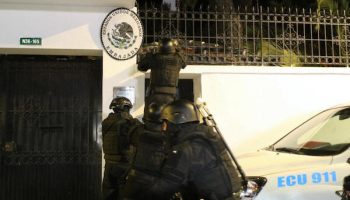
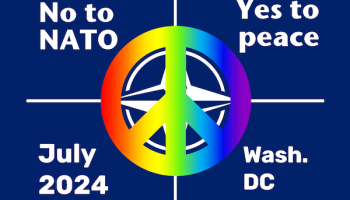
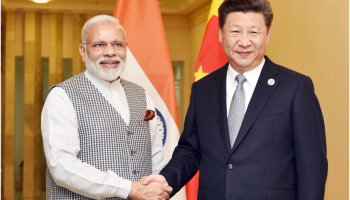
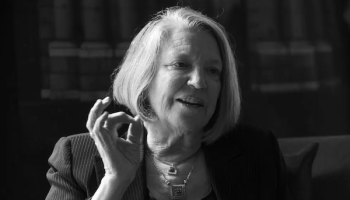
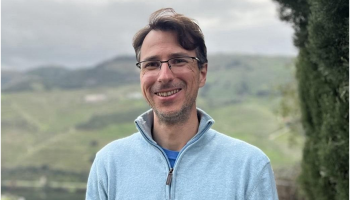
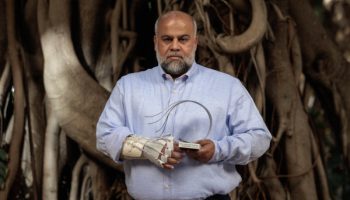
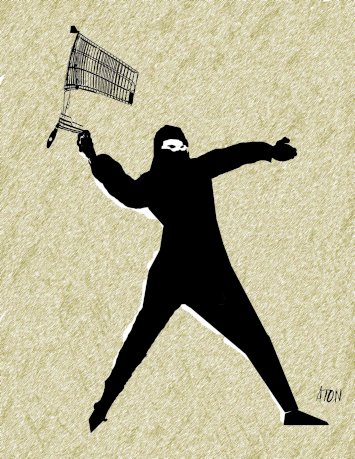



























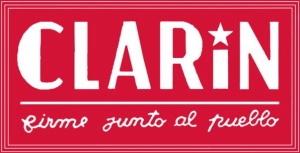

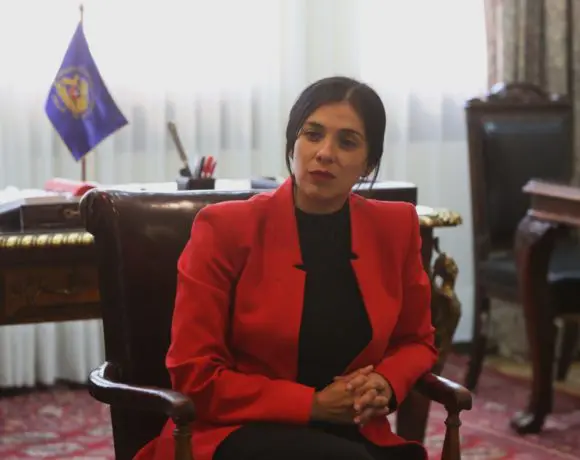
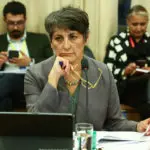
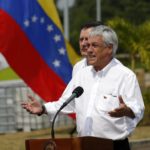
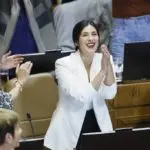

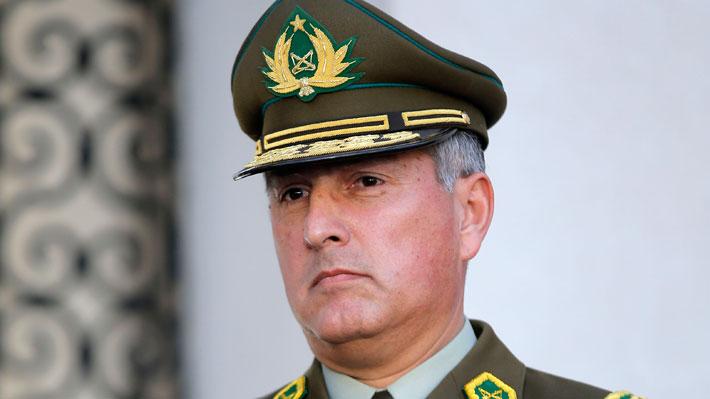
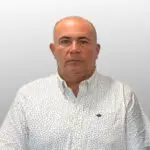
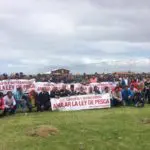
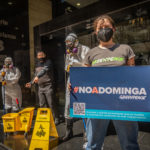
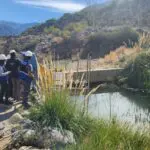
You must be logged in to post a comment Login